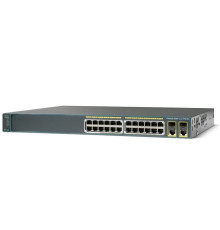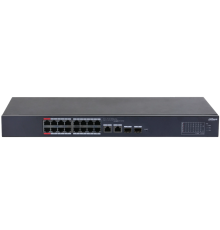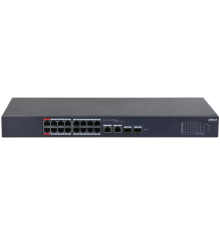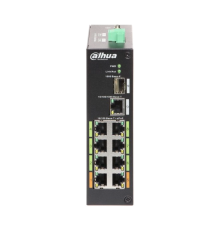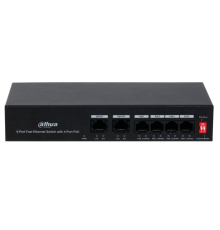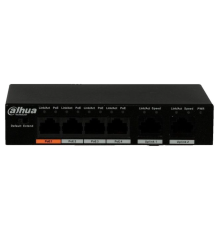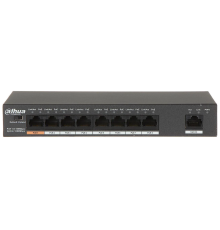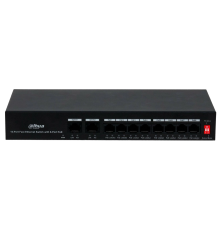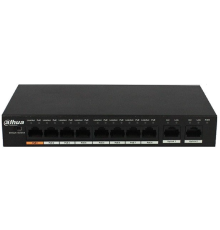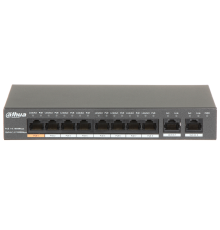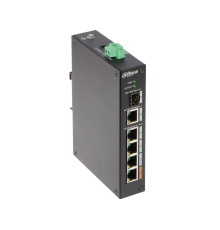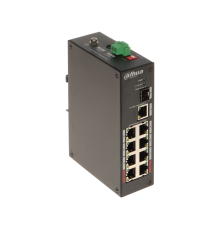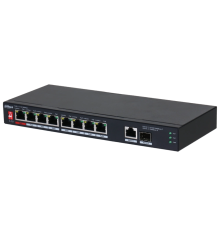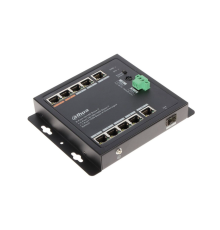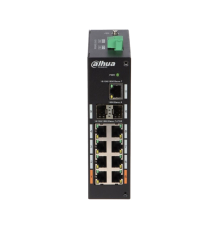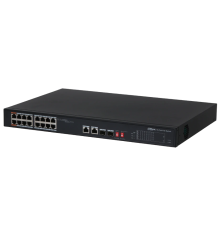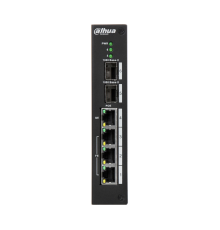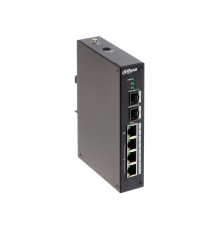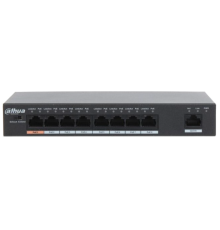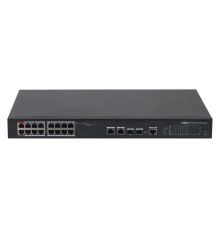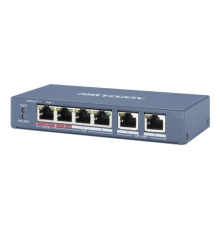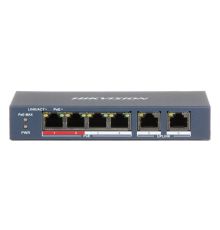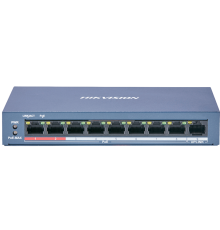
Switches are devices used in computer networks to connect and manage the transmission of data between different computers. They play an important role in organizing local area networks (LAN) and ensure fast and efficient information exchange.
Switches operate based on packet switching technology. They receive incoming data, analyze their addresses, and forward each data packet to the corresponding port connected to a specific computer or other network device. This allows for efficient use of network resources and ensures stable and fast data transmission.
Switches can have various configurations and capabilities. They can be hierarchical, meaning they support separate configuration and management of each port, or be managed by a single central system. There are also switches with different numbers of ports - from a small number to several hundred. Switches can be connected to other network devices, such as routers or network storage, to expand the network's capabilities.
The main advantage of switches is their high data transmission speed. They provide low latency and minimize collisions - situations where multiple devices try to transmit data simultaneously. This allows for efficient use of network bandwidth and ensures stable and fast network operation.
Switches also have built-in security mechanisms that help protect the network from external threats, such as unauthorized access or DoS attacks. They can provide network segmentation, establish access control, and monitor traffic to detect anomalous behavior.
Overall, switches are important elements of network infrastructure that ensure efficient and reliable operation of computer networks. They enable high-speed and secure interaction between computers and other devices in the network, which is the foundation of modern information infrastructure.
Switches operate based on packet switching technology. They receive incoming data, analyze their addresses, and forward each data packet to the corresponding port connected to a specific computer or other network device. This allows for efficient use of network resources and ensures stable and fast data transmission.
Switches can have various configurations and capabilities. They can be hierarchical, meaning they support separate configuration and management of each port, or be managed by a single central system. There are also switches with different numbers of ports - from a small number to several hundred. Switches can be connected to other network devices, such as routers or network storage, to expand the network's capabilities.
The main advantage of switches is their high data transmission speed. They provide low latency and minimize collisions - situations where multiple devices try to transmit data simultaneously. This allows for efficient use of network bandwidth and ensures stable and fast network operation.
Switches also have built-in security mechanisms that help protect the network from external threats, such as unauthorized access or DoS attacks. They can provide network segmentation, establish access control, and monitor traffic to detect anomalous behavior.
Overall, switches are important elements of network infrastructure that ensure efficient and reliable operation of computer networks. They enable high-speed and secure interaction between computers and other devices in the network, which is the foundation of modern information infrastructure.
Cisco WS-C2960-24TT-L used
Cisco WS-C2960-24TT-L
The Cisco Catalyst 2960 Series Switches are a line of fixed configuration switches with Fast Ethernet and Gigabit Ethern..
8 400.00 грн
Dahua DH-CS4218-16ET-135 PoE 100 Mbps 16-port managed
DH-CS4218-16ET-135
Dahua DH-CS4218-16ET-135 PoE is a managed 16-port switch with Power over Ethernet (PoE) technology and a data transfer r..
10 517.59 грн
Dahua DH-CS4218-16ET-190 PoE 100 Mbps 16-port managed
DH-CS4218-16ET-190
Dahua DH-CS4218-16ET-190 PoE is a 16-port managed switch with support for data transmission over an Ethernet network. It..
13 093.32 грн
Dahua DH-LR2110-8ET-120 PoE 100 Mbps 8-port
DH-LR2110-8ET-120
Dahua DH-LR2110-8ET-120 PoE is a high-quality 8-port switch equipped with Power over Ethernet (PoE) function, which prov..
8 800.43 грн
Dahua DH-PFS3006-4ET-36 PoE 100 Mbps 4-port
DH-PFS3006-4ET-36
Dahua DH-PFS3006-4ET-36 PoE is a 4-port switch with Power over Ethernet (PoE) technology support and data transmission s..
2 189.37 грн
Dahua DH-PFS3006-4ET-60 PoE 100 Mbps 4-port
DH-PFS3006-4ET-60
Network switch Dahua DH-PFS3006-4ET-60 PoE is a high-quality device that provides data and power transmission for IP dev..
2 404.02 грн
Dahua DH-PFS3006-4GT-60 PoE 1000 Mbps 4-port
DH-PFS3006-4GT-60
Dahua DH-PFS3006-4GT-60 PoE is a 4-port switch with Power over Ethernet (PoE) support and data transfer speed of up to 1..
3 133.81 грн
Dahua DH-PFS3009-8ET1GT-96 PoE 100 Mbps 8-port
DH-PFS3009-8ET1GT-96
Dahua DH-PFS3009-8ET1GT-96 PoE 100 Mbps is an 8-port switch with Power over Ethernet (PoE) support from Dahua. This swit..
3 563.10 грн
Dahua DH-PFS3010-8ET-65 PoE 100 Mbps 8-port
DH-PFS3010-8ET-65
Dahua DH-PFS3010-8ET-65 PoE is a high-quality 8-port switch designed for building reliable data transmission networks. T..
2 962.10 грн
Dahua DH-PFS3010-8ET-96 PoE 100/1000 Mbps 8-port
DH-PFS3010-8ET-96
Dahua DH-PFS3010-8ET-96 PoE is a universal switch designed for high-speed data transmission networks. With its help, you..
4 421.68 грн
Dahua DH-PFS3010-8GT-96 PoE 1000 Mbps 8-port
DH-PFS3010-8GT-96
Dahua DH-PFS3010-8GT-96 PoE is a versatile switch that provides stable connectivity between various network devices. It ..
6 868.63 грн
Dahua DH-PFS3106-4ET-60 PoE 100 Mbps 4-port
DH-PFS3106-4ET-60
Dahua DH-PFS3106-4ET-60 PoE is a 4-port switch with Power over Ethernet support and a data transmission speed of up to 1..
3 648.96 грн
Dahua DH-PFS3110-8ET-96 PoE 100 Mbps 8-port
DH-PFS3110-8ET-96
Dahua DH-PFS3110-8ET-96 PoE is an 8-port switch designed for data and power transmission over Ethernet. It supports Powe..
5 194.40 грн
Dahua DH-PFS3110-8ET1GT1GF-96 PoE 100 Mbps 8-port
DH-PFS3110-8ET1GT1GF-96
Dahua DH-PFS3110-8ET1GT1GF-96 PoE is an 8-port switch specifically designed for use in video surveillance systems. It pr..
5 409.04 грн
Dahua DH-PFS3111-8ET-96-F PoE 100 Mbps 8-port
DH-PFS3111-8ET-96-F
Dahua DH-PFS3111-8ET-96-F is an 8-port switch with PoE support designed for data transmission using Ethernet technology...
7 641.35 грн
Dahua DH-PFS3211-8GT-120 PoE 1000 Mbps 8-port
DH-PFS3211-8GT-120
Dahua DH-PFS3211-8GT-120 PoE is a high-quality 8-port switch with Power over Ethernet (PoE) support, designed for use in..
10 732.23 грн
Dahua DH-PFS3218-16ET-135 PoE 100 Mbps 16-port unmanaged
DH-PFS3218-16ET-135
Dahua DH-PFS3218-16ET-135 PoE is a 16-port unmanaged switch with Power over Ethernet (PoE) support and data transfer spe..
10 302.94 грн
Dahua DH-PFS4206-4P-120 PoE 100 Mbps 4-port
DH-PFS4206-4P-120
Dahua DH-PFS4206-4P-120 PoE is a 4-port switch designed for connecting network devices in small and medium-sized network..
6 224.69 грн
Dahua DH-PFS4206-4P-96 PoE 100/1000 Mbps 4-port
DH-PFS4206-4P-96
Dahua DH-PFS4206-4P-96 PoE is a 4-port switch with Power over Ethernet (PoE) support and a data transfer rate of 100/100..
5 366.12 грн
Dahua PFS3009-8ET-96 PoE 100 Mbps 8-port
PFS3009-8ET-96
Dahua PFS3009-8ET-96 PoE is an 8-port switch that supports Power over Ethernet (PoE) and provides data transmission at s..
3 434.31 грн
Dahua PFS4218-16ET-190 PoE 100 Mbps
PFS4218-16ET-190
Dahua PFS4218-16ET-190 PoE is a managed switch with 16 ports, equipped with Power over Ethernet (PoE) technology and sup..
12 664.03 грн
Hikvision DS-3E0106HP-E PoE 100 Mbps
DS-3E0106HP-E
Hikvision DS-3E0106HP-E PoE is a compact and user-friendly 4-port unmanaged switch, specially designed for data and powe..
2 747.45 грн
Hikvision DS-3E0106P-E/M PoE 100 Mbps
DS-3E0106P-E/M
Hikvision DS-3E0106P-E/M PoE is a compact and reliable unmanaged switch with four ports, capable of providing high-speed..
2 300.99 грн
Hikvision DS-3E0109P-E(C) PoE 8-port switch
DS-3E0109P-E(C)
Hikvision DS-3E0109P-E(C) is an 8-port PoE switch developed by Hikvision, a global leader in video surveillance and secu..
4 842.38 грн
Showing 1 to 24 of 57 (3 Pages)
